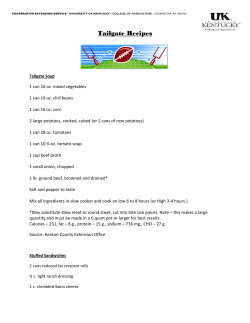
How to Make Tailgate Training Work T S
Tailgate Training Tip Sheet® – No. 96 Copyright 2009 How to Make Tailgate Training Work Editor’s note: Our Tailgate Training Tip Sheets are available in Spanish at www.gemplers.com. Key Points: •Commit to a tailgate training program on a weekly basis. •Conduct training sessions in a language your workers understand. •Involve employees in your training sessions. Note to trainer: This is a special Tailgate Training Tip Sheet for supervisors and other trainers that is designed to help you make your tailgate program more effective. This Tip Sheet may be photocopied for your internal use, but it may not be published or sold. The basics of tailgate training • “ Tailgate” training is a 10- to 15-minute training session on a single safety topic. • |Each session is presented orally to a small group of workers around the tailgate of a truck, in the field, or in another spot that’s comfortable for workers. • Supervisors or the workers themselves should present the training in a language trainees understand. • Tailgate training is most effective when it is held on a weekly basis. Keep conducting the training during harvest and other busy seasons because that’s when most injuries are likely to occur. • Hold tailgate sessions early in the week, if possible, at a specific dedicated time. • Allow time at the end of each session for questions. • Document attendance at each session. Tips on making your program work • C hoose trainers who have a good rapport with your workers so trainees are comfortable and are willing to participate. • While human resources staff or other high level managers may initially start a tailgate program, be sure they turn it over to the supervisor in charge of the specific area after a short period of time. This is important so either the supervisor or another worker trainees consider one of their “peers” does the training – versus someone they consider an “office” person who may not fully understand their job. • Once you have started a tailgate program, don’t stop it, then try to re-start it at a later date. • Don’t be afraid to let workers take turns giving the presentations. This is a good way to achieve “buy-in” and make employees feel they are important. • Involve everyone, if possible. One good way to do this is to have workers take turns reading the “Do’s” and “Don’ts” at the bottom of your tailgate script. Be sure you have documented attendance at each tailgate safety meeting. (Continued on back) See our full line of safety supplies, including respirators, eye and ear protection, coveralls, first aid and more. GEMPLER’S® • P.O. Box 45800 • Madison, WI 53744-5800 • Phone: 1-800-382-8473 • www.gemplers.com Tailgate Training Tip Sheet® – No. 96 (continued) Copyright 2009 How to Make Tailgate Training Work The benefits of tailgate training • A regular tailgate training program can dramatically reduce your injury rates, as well as your injury-related insurance costs. Fewer injuries also reduce the costs associated with retraining or hiring new workers, plus any associated production downtime costs. • Weekly tailgate training lets your workers know that safety is a high priority in your operation. • An effective tailgate program can be used as “evidence” of your commitment to safety if you are investigated by OSHA or face a lawsuit in connection with an alleged safety-related violation. • Brief tailgate safety sessions can enhance two-way communication An effective tailgate program can between workers and supervisors. be used as evidence of your Other important tailgate training tips 1. Get employees to participate. This is often difficult to do. One good way is to have trainees “demonstrate” anything that can be demonstrated. For example, if the session is on protective clothing, have one of the workers try on the clothing that is being discussed. If the session is on understanding material safety data sheets, give each person an actual MSDS and have trainees take turns pointing out the different sections. 2. Make use of visual aids. Start collecting these items and keep them in a file cabinet for use at future sessions. These might include frayed electrical cords (for a session on electrical safety), damaged tools (for a session on hand-held tools), or a worn-out slow moving vehicle (SMV) emblem (for a session on SMVs). 3. Don’t “lecture.” Choose trainers who are enthusiastic, and won’t drone on in a monotone voice. It’s best if the trainer is familiar with the information on a tailgate script, and can present it in his or her own words. 4. Choose topics that relate to your workers. Review your operation’s past injury and “near miss” records. Walk around and look for potential hazards. Pay attention to what’s in the news. And ask employees for their ideas. 5. Be SURE trainees understand. Go over the training script ahead of time, if possible, and look for any words or language that may be confusing to your workers. Stop during the actual session and ask employees questions to make sure they are following what is being said. Know that some of your employees may not be able to read, even in their native language. commitment to safety should an OSHA inspector unexpectedly knock at your door. Review your tailgate materials in advance so you’re sure there are no words your employees might not understand. EFFECTIVE TAILGATE TRAINING DO’S AND DON’TS DO: •Choose trainers who are respected by your workers. •Choose topics your workers can relate to. •Train workers in a language they understand. DON’T: •Have “office” management conduct your tailgate sessions. •Lecture, or talk down to the workers. •Neglect to do training during your busy seasons. See our full line of safety supplies, including respirators, eye and ear protection, coveralls, first aid and more. GEMPLER’S® • P.O. Box 45800 • Madison, WI 53744-5800 • Phone: 1-800-382-8473 • www.gemplers.com
© Copyright 2025











